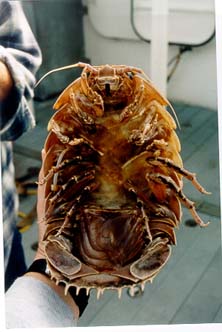
A Bathynomus giganteus removed from a trap. Over two dozen of these giant isopods were captured, including two juveniles less than 10 cm long. The students studied these creatures' blood proteins, stable isotopes and epibionts.
Giant Isopods for Valentine's Day
Student Report
February 14, 2003
Tracey Smart, Master's Candidate
Oregon Institute of Marine Biology
University of Oregon
After three days of beautiful weather and calm seas, Valentine's Day dawned on the ship in the company of 3- to 4- ft swells, clouds, and wind. Unfortunately, this meant that the day's scheduled dives had to be cancelled. A dive had been planned at Bush Hill, home to hundreds, if not thousands, of tubeworm colonies. Several of the scientists had been waiting for more specimens and were disappointed. Nevertheless, all was not lost.
Instead of diving on Bush Hill, we returned to a muddy plain near the Brine Pool to retrieve the large trap that we had baited and released five days earlier. We were hoping to collect large crabs, the giant isopod Bathynomus giganteus, and small amphipods that, hopefully, would be attracted to the bait. We were not disappointed!
With the winch on the starboard side of the ship, we pulled up three barrels of rope and our trap, brimming with isopods. Once the trap was on board, we removed and examined the animals. Several large Bathynomus, each more than a foot long, were among the 20 or so captured. Among them were half a dozen females that possessed their oostegites (brooding legs that develop in the molt preceding reproduction). That none of these females carried any developing young led us to hypothesize that they had only recently spawned. This hypothesis was further supported by the fact that only two very small isopods (about 6 cm long) were brought up with the trap.
Two spider crabs were also in the trap, one of which carried embryos firmly attached to her abdomen. Both crabs also carried barnacles, but of two very different types. The smaller crab was infected with a Rhizocephalan barnacle, a parasite that attaches to its host and then reprograms the host's reproductive behavior and biology to accomplish its own reproduction. The gravid female crab, on the other hand, played host to epibiotic lepadomorph barnacles on the back of her carapace.
For me, the most exciting find of the day was the four mid-sized Bathynomus that carried hundreds of epibiotic barnacles. I had planned to use them to investigate the morphological characteristics that develop in barnacles living on other organisms. We had also planned on lowering a box core into the mud on this plain, and looking at the animals and bacteria living in this often forgotten habitat. Unfortunately, by afternoon the swells were even bigger, so we were content to return to our rooms to ride out the waves.









